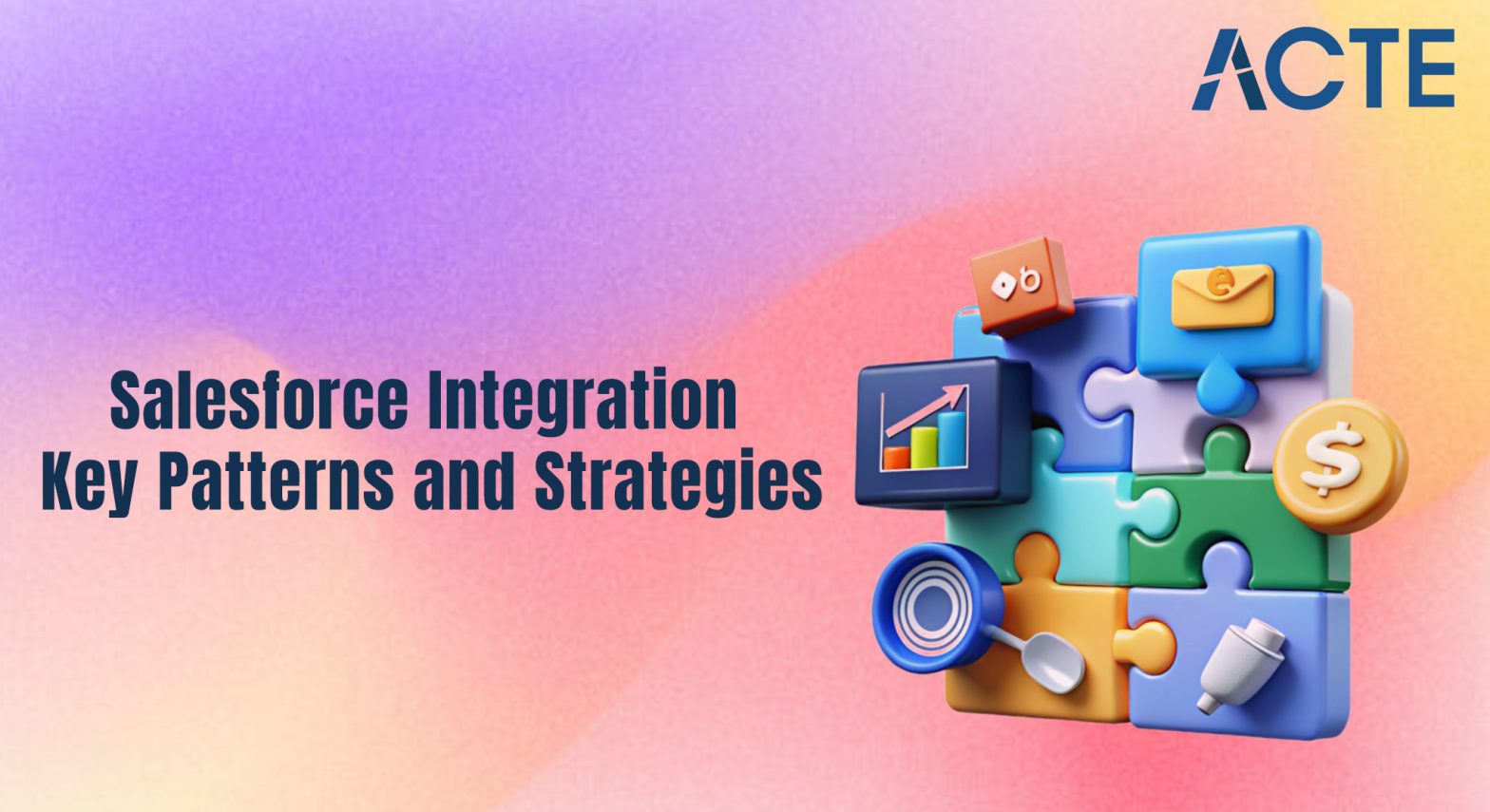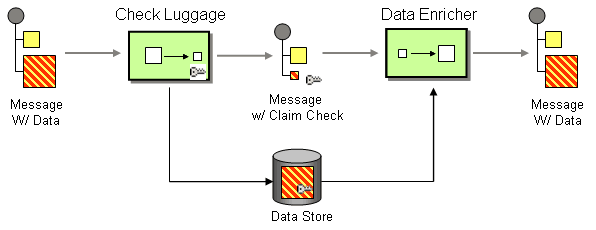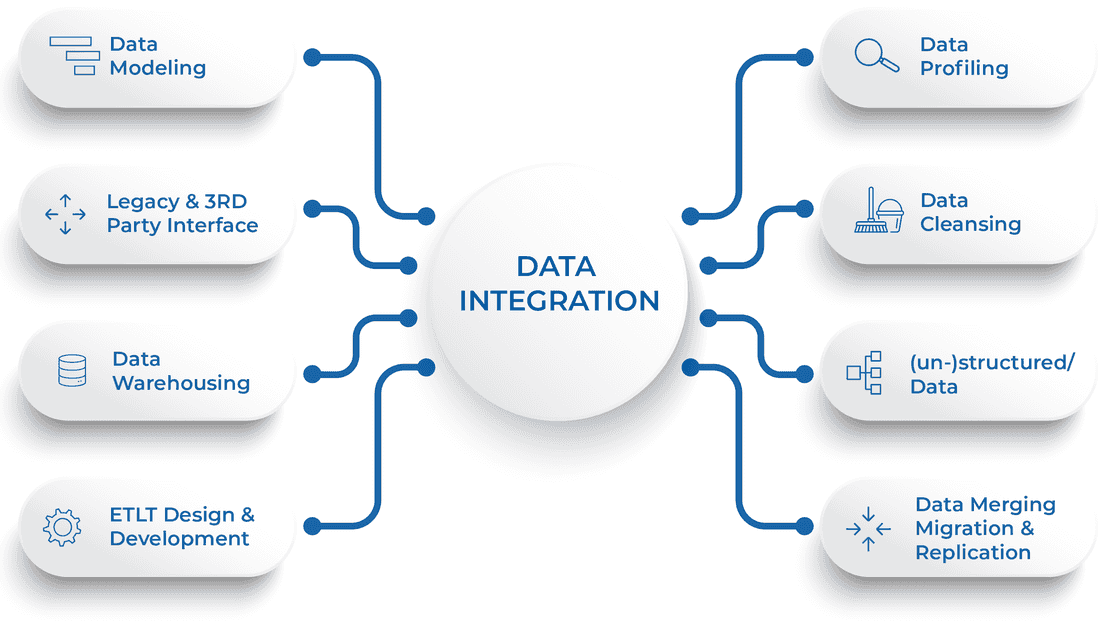
- Introduction to Salesforce Integration
- Types of Integration Patterns
- Point-to-Point Integration
- Batch Data Synchronization
- Remote Process Invocation Request & Reply
- Remote Process Invocation Fire and Forget
- UI Integration Patterns
- Data Integration Best Practices
- Integration Tools and Platforms
- Error Handling and Recovery Mechanisms
- API and Web Service Integration
- Real-World Integration Scenarios
Introduction to Salesforce Integration
Salesforce Integration refers to the process of connecting Salesforce, a leading customer relationship management (CRM) platform, with other systems, applications, or databases to ensure seamless data flow and operational efficiency across an organization. By integrating Salesforce with other software solutions such as marketing automation tools, ERP systems, financial platforms, and social media channels, businesses can streamline workflows, improve customer experience, and gain deeper insights into customer interactions and data. Integration allows for real-time data synchronization, ensuring that teams across departments have access to consistent, up-to-date information. For more details on how to integrate Salesforce, check out the Salesforce Training. This integration can be achieved through various methods, such as APIs, middleware solutions, or third-party apps available on the Salesforce AppExchange. Whether it’s automating data entry, enhancing reporting, or providing a unified view of customer interactions, Salesforce integration enables organizations to break down data silos and improve collaboration. The flexibility of Salesforce’s integration capabilities also allows businesses to scale and adapt their systems as their needs evolve, making it an essential strategy for driving business growth and optimizing operations. Ultimately, Salesforce integration empowers companies to deliver more personalized services, increase productivity, and gain a competitive edge in today’s dynamic business environment.
To Explore Salesforce in Depth, Check Out Our Comprehensive Salesforce Training To Gain Insights From Our Experts!
Types of Integration Patterns
- Data Integration: This pattern focuses on synchronizing and sharing data across systems in real-time or in batch processes. It ensures that information is consistent across various platforms, improving data accuracy and decision-making.
- Process Integration: Process integration connects different systems to automate end-to-end workflows. This pattern eliminates manual interventions by coordinating processes between applications, enhancing operational efficiency.
- User Interface (UI) Integration: UI integration involves creating a unified interface that allows users to access multiple systems through a single platform. This enhances user experience by providing easy navigation and a seamless workflow. For more information, check out the Top Features of Salesforce Lightning.
- API Integration: API integration utilizes Application Programming Interfaces to enable communication between disparate systems. It allows for real-time data exchange, enhancing flexibility and scalability while maintaining system independence.
- Batch Integration: This pattern involves collecting and processing data in bulk at scheduled intervals. It is best suited for non-time-sensitive applications where data accuracy is more important than real-time updates.
- Event-Driven Integration: In this pattern, systems are triggered by specific events or changes in data. This approach is particularly useful for systems that need to respond instantly to real-time events, such as transactions or user actions.
Point-to-Point Integration
Point-to-Point Integration refers to a direct, one-to-one connection between two systems or applications, where data flows from one system to another without the use of intermediaries or additional integration layers. In this model, each system communicates directly with the other through custom-built interfaces, often leveraging APIs, file transfers, or direct database connections. This approach is simple to implement for small-scale integrations where only a few systems are involved.However, as the number of systems or applications grows, point-to-point integration can become complex and difficult to manage, as each new connection requires the development of individual interfaces. To streamline this, check out how to Use Salesforce Record Types. This results in an increase in maintenance overhead, a higher risk of errors, and limited scalability. Furthermore, any changes made to one system might require adjustments in all connected systems, making the solution less flexible. While point-to-point integration can be cost-effective and efficient for smaller setups, it often lacks the flexibility and scalability needed for more complex or dynamic environments. As organizations scale, they often transition to more advanced integration models, such as hub-and-spoke or middleware-based architectures to reduce the complexities associated with managing multiple point-to-point connections. Nonetheless, point-to-point integration remains useful in specific scenarios where simplicity and direct connections are prioritized.
Do You Want to Learn More About Salesforce? Get Info From Our Salesforce Training Today!
Batch Data Synchronization
Batch Data Synchronization is a method of transferring and updating data between systems at scheduled intervals, typically in large, predefined chunks or batches. Instead of real-time data exchange, batch synchronization involves collecting data over a period and then processing and transferring it at a specified time, such as daily, weekly, or monthly. This approach is often used in scenarios where immediate data updates are not crucial and performance efficiency is prioritized. For example, In situations like end-of-day financial reporting, inventory updates, or bulk data migrations, batch processing allows organizations to reduce system load and ensure that data is consistently updated across multiple systems. For helpful guidance, check out these Salesforce Data Loader Tips. While batch synchronization can be more resource-efficient and less complex than real-time synchronization, it may not be suitable for systems requiring instant data updates or when time-sensitive actions need to be taken. Additionally, the process may introduce delays in data visibility, as changes made in one system may not be reflected in others until the next batch run. Despite these limitations, batch data synchronization remains a valuable solution for managing large volumes of data in a controlled, cost-effective manner, particularly in less time-sensitive environments or legacy systems.
Remote Process Invocation Request & Reply
Remote Process Invocation Request & Reply is an integration pattern where one system (the requester) sends a request to a remote system (the provider), which processes the request and returns a response, typically over a network using protocols like HTTP, SOAP, or REST. This pattern follows a synchronous communication model, meaning the requester waits for the reply before proceeding, ensuring that the response is received before any further actions are taken. It is commonly used in scenarios where real-time interaction is required, such as querying an external database, invoking a web service, or triggering processes in remote applications. While this approach ensures reliability and direct communication between systems, it can introduce delays due to network latencies and system processing times, especially when the remote system is under heavy load. Additionally, the synchronous nature of the process can limit scalability and system performance when handling high volumes of requests. Despite these potential challenges, Remote Process Invocation Request & Reply remains a valuable integration method when immediate feedback is crucial for business operations or workflows.

Remote Process Invocation Fire and Forget
- Asynchronous Communication: In this pattern, the request is sent asynchronously, meaning the sender does not need to wait for the remote process to complete. The system continues with its operations, reducing waiting times and improving efficiency.
- No Response Handling: Unlike other integration patterns, Fire and Forget does not require the requester to handle or process any response. The sender simply triggers the remote process and moves on. To learn more about succeeding in this role, check out Succeed as a Salesforce Business Analyst.
- Improved System Performance: Since the system does not need to wait for a reply, it can continue to perform other tasks or handle additional requests, enhancing overall system throughput and responsiveness.
- Ideal for Non-Critical Operations: This pattern is particularly useful for operations where the outcome is not immediately critical, such as logging data, sending notifications, or triggering background tasks.
- Reduced Complexity: Without the need to process responses, the implementation of Fire and Forget can be simpler, as it avoids managing the complexities of response timeouts, error handling, or retries.
- Potential for Data Loss: A downside of this approach is the risk of data loss if the remote system fails to process the request, as there is no way to confirm whether the action was successfully completed.
Remote Process Invocation Fire and Forget is an integration pattern where a system sends a request to a remote process or service but does not wait for a response. This method is commonly used when the requester does not need an immediate reply or when the request does not affect the subsequent workflow of the system. The “fire and forget” approach improves performance and scalability by allowing systems to continue processing other tasks without waiting for a response from the remote system.
UI Integration Patterns
UI Integration Patterns refer to strategies for combining and presenting data from multiple systems into a unified user interface (UI), allowing users to access and interact with information from various applications seamlessly. These patterns aim to provide a consistent and cohesive user experience, even when the underlying systems are diverse or located across different platforms. Common UI integration patterns include iframe Embedding, where an external application is embedded into the UI of a primary system, and Single Sign-On (SSO), which simplifies authentication by allowing users to log in once and access multiple systems without needing separate credentials. Another approach is Screen Scraping, where a UI extracts and displays data from an existing system that may not offer APIs or direct integration methods. Mashups combine data from different sources into a single UI, offering users a comprehensive view without needing to switch between applications. Web Services and RESTful APIs can also be used to fetch data and display it within a UI without disrupting the user’s interaction flow. UI integration patterns are essential for enhancing user productivity, minimizing context-switching, and improving overall efficiency by offering a unified, easy-to-navigate interface, especially in complex, multi-system environments. However, careful attention must be paid to maintaining performance and security.
Preparing for a Salesforce Job Interview? Check Out Our Blog on Salesforce Interview Questions and Answers
Data Integration Best Practices
Data integration is crucial for ensuring seamless communication between various systems and applications within an organization. To achieve optimal results, following data integration best practices is essential. First, establish clear data governance policies to ensure consistent data quality and security across systems. This involves defining data ownership, access controls, and data validation rules to maintain integrity. Next, choose the right integration tools and technologies, selecting solutions that are scalable, secure, and capable of handling the volume and complexity of your data. For guidance on using Salesforce integration tools, check out the Salesforce Training. Implementing real-time data synchronization can be a game-changer for businesses needing up-to-date information across systems, while batch processing remains effective for non-time-sensitive data. Another best practice is to standardize data formats to reduce errors and ensure compatibility between different systems. It’s also vital to monitor data flows and performance continuously, identifying and resolving any bottlenecks or failures in real time. Furthermore, ensure that data transformations are efficient, meaning that the process of mapping and converting data between systems is automated and streamlined to reduce manual intervention. Finally, plan for data scalability by designing your integration architecture to accommodate future growth, ensuring that your systems remain efficient and effective as your data needs evolve. By adhering to these best practices, businesses can ensure smooth, accurate, and reliable data integration across their ecosystems.

Integration Tools and Platforms
- Middleware Solutions: Middleware tools facilitate communication between different systems and applications, enabling seamless data exchange. Examples include MuleSoft and IBM Integration Bus, which connect disparate environments and manage complex data flows.
- API Management Tools: Platforms like Postman, Apigee, and Kong are essential for creating, testing, and managing APIs. They ensure secure, reliable communication between applications by offering advanced features like API monitoring, analytics, and version control.
- Cloud Integration Platforms: Cloud-based integration tools such as Dell Boomi, Informatica Cloud, and SnapLogic simplify the process of connecting cloud and on-premise applications. These platforms provide pre-built connectors and templates, making it easier to automate data flows and reduce integration complexity.
- ETL (Extract, Transform, Load) Tools: Talend, Apache Nifi, and Microsoft SSIS are powerful ETL platforms designed for data integration. They automate the extraction, transformation, and loading of data into a centralized repository, helping businesses manage large-scale data operations efficiently. For insights on automating workflows, check out Workflow with Salesforce Approval Process.
- IPaaS (Integration Platform as a Service): Tools like Workato, Zapier, and Jitterbit offer cloud-based integration solutions that require minimal coding. These platforms are ideal for automating workflows, connecting SaaS applications, and integrating cloud-based and on-premise systems.
- Enterprise Service Bus (ESB): Red Hat Fuse and WSO2 ESB are examples of ESB solutions that enable centralized management of integrations within large enterprises. They help in message routing, transformation, and ensuring smooth communication between diverse services and applications.
These integration tools and platforms are crucial for businesses looking to enhance their system interoperability, streamline workflows, and ensure efficient data management across their infrastructure.
Error Handling and Recovery Mechanisms
Error handling and recovery mechanisms are essential components of any integration process, ensuring that systems can handle failures gracefully and recover without significant disruption to operations. These mechanisms involve detecting, managing, and responding to errors that may occur during data exchange or process execution. A key aspect of error handling is detection, which involves monitoring systems for unexpected behaviors or failures, such as data inconsistencies, connectivity issues, or system crashes. Once an error is detected, logging and alerting mechanisms should be in place to notify relevant personnel or trigger automated responses. To explore the key functionalities, check out the Features of Salesforce Sales Cloud. Retry strategies are commonly employed to handle transient errors, where a failed operation is retried after a short delay, often with an exponential backoff to avoid overloading the system. For more severe issues, compensation actions may be necessary, where processes are rolled back or alternative actions are taken to ensure data consistency and system integrity. Error escalation should be part of the recovery process, ensuring that complex issues are flagged for manual intervention. Additionally, monitoring tools that provide real-time insights into system performance and error trends are crucial for proactive problem resolution. A robust error-handling and recovery strategy ensures minimal downtime, preserves data integrity, and enhances the overall reliability of integrated systems.
Would You Like to Know More About Salesforce? Sign Up For Our Salesforce Training Now!
API and Web Service Integration
- Facilitates Communication Between Systems: API and Web Service Integration enables different applications or systems to communicate and share data, regardless of their platform or technology. APIs (Application Programming Interfaces) and web services allow seamless data exchange using standardized protocols like HTTP, SOAP, and REST.
- Real-Time Data Exchange: Through API and web service integration, data can be exchanged in real time, ensuring that applications always have the most up-to-date information. This is essential for applications like e-commerce platforms, financial systems, or customer service tools that need constant synchronization.
- Enhances Scalability and Flexibility: APIs and web services enable easy scalability, as they allow developers to add new features or integrate additional services without disrupting existing systems. This flexibility helps organizations grow and adapt quickly to changing business needs. To explore career development opportunities, check out the Top Salesforce Certifications and Job Paths.
- Simplifies Integration of Third-Party Services: Web services and APIs make it easier to integrate third-party applications and services into your system, such as payment gateways, social media platforms, or data storage providers. This integration reduces the need for manual data entry and streamlines workflows.
- Security and Authentication: API and web service integration typically includes robust security mechanisms such as authentication (OAuth, API keys) and encryption (SSL/TLS) to ensure that data exchanged between systems remains secure and that only authorized users can access sensitive information.
- Error Handling and Monitoring: With API and web service integration, built-in error handling and monitoring features ensure that failures or issues in communication are quickly detected and addressed. This enhances reliability, ensuring that users experience minimal disruption and that issues are resolved promptly.
By using API and web service integration, businesses can create interconnected systems that improve efficiency, ensure accurate data sharing, and provide flexibility for future growth and innovation.
Real-World Integration Scenarios
Real-world integration scenarios are common situations where businesses or organizations leverage integration technologies to streamline operations, enhance data sharing, and improve efficiency. For instance, in e-commerce, integration between an online store’s website and inventory management system ensures that stock levels are automatically updated in real time, reducing the risk of overselling and improving customer experience. Another example is in the healthcare sector, where integration between Electronic Health Records (EHR) systems and various medical devices allows for seamless data exchange, enabling accurate patient monitoring and enhancing the quality of care. In finance, integration between banking systems and payment gateways ensures secure, efficient transactions, enabling real-time processing of payments. Similarly, in the supply chain industry, integrating logistics management platforms with inventory and ERP systems ensures that goods are tracked efficiently from manufacturer to customer, optimizing operations and reducing delays. For more insights on integrating Salesforce, check out the Salesforce Training. Integration is also crucial in customer relationship management (CRM) systems, where linking marketing automation tools and sales platforms provides a unified view of customer interactions and helps create personalized marketing strategies. These real-world scenarios highlight the importance of integration in ensuring that disparate systems work together smoothly, enabling businesses to respond faster, improve customer satisfaction, and drive overall operational efficiency.




